Students Demand Accountability Following Instagram Post
Last Friday, students gathered around the steps of Coram Library in protest of a Bates College Instagram post published on Oct. 27. The post featured the President of Bates College Republicans along with a short profile, including quotes on their conservative political views. This was part of a bipartisan series highlighting students voting in their first presidential election.
Many students commented on the post, expressing their disagreement and disappointment with Bates for publishing it. After several hundred comments had been written, Bates disabled comments, blocking further comments and hiding previous ones from view.
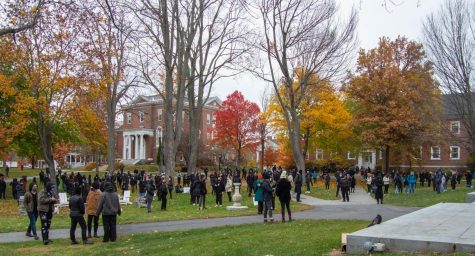
A few hours later, Bates posted a statement from President Clayton Spencer on Instagram defending the college’s actions, writing the project aimed to reflect “a range of personal motivations and political viewpoints.” Comments were also disabled on this post.
Numerous students condemned these actions, decrying Bates for limiting discussion and concealing students’ criticism. Bates then re-enabled the comments the following day, which allowed for new comments to be posted and for old comments to be visible.
In response to these actions, the Bates College Student Government (BCSG) organized a socially distanced protest. BCSG co-presidents, Perla Figuereo ‘21 and Lebanos Mengistu ‘21, were seen giving hand warmers to the many protestors who had come and braved the cold weather. Members of the Bates community were also able to participate in the protest virtually through Zoom and broadcasted via Instagram live video.
Hundreds of students attended the protest in person, along with some members of the staff and faculty. The protest lasted nearly two hours
‘Bates Will Not Silence Us’
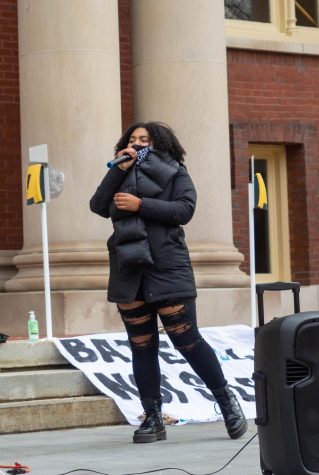
After an introduction by Figuereo and Mengistu, Student Government Representative, Rishi Madnani ‘23, was the first to speak. “Free speech does not mean you can protect hate speech,” Madnani said, referencing President Spencer’s response posted on Instagram. Madnani further explained that just because a person can lawfully say what they choose does not mean others cannot criticize.
A white sheet lay on the steps of Corum painted with the phrase “Bates Will Not Silence Us”—a theme carried throughout the protest. Students stepped up to add their handprint during the protest.
Sam Jean-Francois ‘23 spoke about the reasons behind the protest and how the protest is larger than the student featured in the Instagram post.
“This protest isn’t fascism, or hypocrisy, or any other term being used to stray away from the focus of the protest,” Jean-Francois said. “This is a response to the silencing of current, past, and potentially future BIPOC, queer, and international students.”
Jean-Francois also expressed the difficulty in putting feelings into words, especially when “tired, angry, annoyed, and frustrated” no longer feel right. “None of these words can express how I feel as I prepare for another Zoom call. As I prepare to explain myself again. As I prepare to speak against silence,” Jean-Francois shared.
President Spencer was present at the protest to apologize, answer questions, and listen to concerns expressed by students. She apologized for the added harm, fear, and feelings of unsafety inflicted on the Bates community.
“It was incredibly insensitive of me to speak out about the election without taking that into account,” Spencer said.
Criticism of Bates and Protest Demands
After many students, and one faculty member — Associate Professor of Digital and Computational Studies, Professor Carrie Diaz Eaton — spoke on the messages of the protest, Figuereo and Mengistu stood on the Coram steps to explain that they were not just here to “yell,” but they were here with demands. These demands included:
- An apology from the Bates administration regarding the silencing of students and restriction of free speech.
- Deletion of the Instagram post.
- A direct stance against racism with a commitment to anti-racism work.
- Commitment from all affiliated Bates student organizations to anti-racism work.
- A requirement for all Bates students to take a course in critical race theory
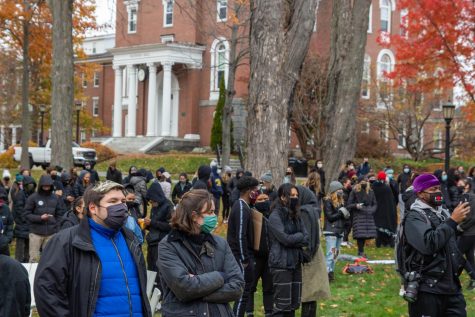
Organizers demanded that Bates should require all students to take a critical race theory course, among other demands. (Katherine Merisotis/The Bates Student)
Spencer was also asked to hold open office hours for students to express their beliefs and concerns. Spencer has regular open office hours which students may sign up for, although this was not initially clear to many students in attendance. Spencer said she welcomes students to come talk with her, and if needed, she will set aside more time to meet.
Additionally, Madnani and Alya Yousuf ‘21 pointed to the discrepancies in Bates’ mission statement and Bates’ treatment of BIPOC students.
“This school loves to talk about their abolitionist history,” Madnani said. “They love to talk about their anti-racism commitment, so it is time to hold them to that!” Yousuf pressed Dean of Faculty Malcom Hill on this issue, asking: “Why is the word ‘abolitionists’ still in our mission statement?”
Yousuf further elaborated that while Bates prides itself on being “one of the first U.S. institutions of higher learning to admit women and people of color,” the school still needs to be held accountable to its mission statement. “To claim to be a school founded by abolitionists means that we are a school that has historically fought against racism and oppression,” she said.
Yousuf and other members of BCSG feel that Bates is leveraging the claim “founded by abolitionists” in order to attract students to Bates and increase the diversity of their student body.
“People hear about our abolitionist past, and our past anti-racist history,” she said. “Many people choose Bates because of its history and mission statement.
She asked that Bates “Stop capitalizing on this abolitionist story” unless it is willing to commit to anti-racism reform.
Student Profile Sparks Protest
On Oct. 23, the Bates Communications Office posted a slideshow online featuring eleven students who were voting in their first presidential election. They planned to post a profile of one student a day leading up to the election on the Bates College Instagram, beginning Oct. 25.
The post profiling the president of Bates College Republicans was only the third of the profiles to be posted, and at that point, it was the only post that referenced a student organization affiliated with a political party.
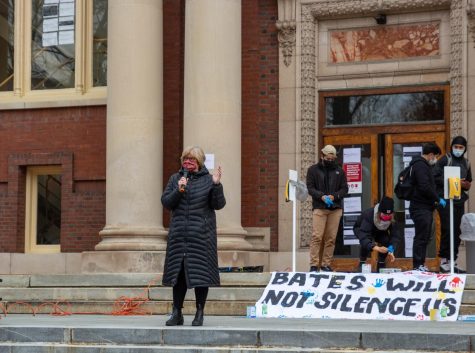
All but one of the eleven students featured in the series belonged to either neutral or left-leaning student organizations, including Bates Votes, High Altitude Ballooning Club, and the Environmental Coalition.
Some of these students whose profiles never made it to Instagram included Figuereo and Mengistu from BCSG, Anni Gundeck ‘21 from the Reproductive Justice Alliance, and Miles Nabritt ‘21 from Bates Votes and Model United Nations.
This post was released only a day after the Supreme Court Judge Amy Coney Barrett was confirmed, cementing a 6-3 conservative majority and upsetting students. This may have contributed to the fierce condemnation of the Instagram post.
Several hundred students commented on the Instagram post. Some commenters expressed their disappointment and criticism of the post, others attacked the featured student and mocked Bates’ decision.
In Spencer’s statement posted later that day, she explained that the series was focused on providing a “non-partisan window” on civic engagement and was meant to include a wide range of political perspectives. In reference to the right of free speech, she said “Any attempt to filter out certain voices is unacceptable, particularly in a campus community that should prize free and open discourse,” President Spencer wrote.
Many students disapproved of this statement and commented on the hypocrisy of invoking the right to free speech after Bates had disabled comments on both Instagram posts. Bates enabled comments the following evening on both posts after removing comments from the student profile which violated their comment policy.
Communications Director Sean Findlen explained at the protest that many mistakes were made at the time the Instagram post went up and assured students that the Instagram post would be deleted.
“To be clear, that’s not where it should stop…I need to do more work, my colleagues need to do more work,” he said.
The entire series of posts about voting and the initial statement from Spencer were deleted following the protest.
Demand for Critical Race Theory Course Requirement
Dean Hill spoke to the demand that all students be required to take a course in critical race theory in order to graduate: “The Dean of Faculty doesn’t have that kind of authority…the faculty control the curriculum.” However, Dean Hill assured students that the idea would be brought up in the next Academic Affairs Committee meeting.
On Wednesday, the Academic Affairs Committee sent out an email inviting all students to a Zoom meeting to discuss “to better understand the objectives, goals, and challenges of a curricular requirement of this sort.”
This meeting will be held on Nov. 12th from 6:30-7:30 pm. The committee stated that additional meetings will be planned as needed in order to enable full participation. “Once feedback has been collected, we can discuss potential pathways with the broader community,” they wrote in their email.
Students Demand “The Time is Now”
Speakers at the protest emphasized the amount of work that is still needed to make Bates a place where BIPOC voices are actively supported and listened to.
“Clap if you have done everything in your power to make sure Black bodies feel comfortable,” Adama Diaby ‘22 asked of those assembled. “Clap if you make sure not to enable the white supremacist ideals here at Bates.” She then pointed out how few students, and how few white students in particular, were clapping.
Ali Manning ’23 made it very clear that the work of anti-racism should not fall on BIPOC students alone; white students need to show up, too and they need to hold each other accountable. Addressing the white students in the crowd, she said: “What are you going to do after today? We need to do better – this is our work too!”
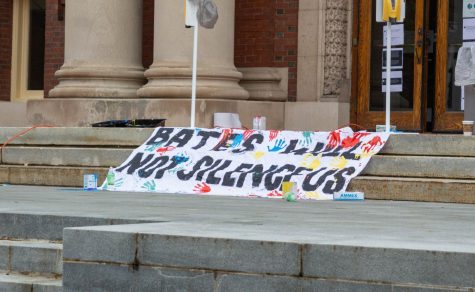
Referencing the other speakers, Josh Redd ‘21 stated: “Everything we have been talking about are things we have been talking about our whole lives…I think it is important that everyone in the crowd asks themselves the question: ‘Why now? Why not two years ago?’”
In highlighting the urgency of this moment, Redd added: “I am not saying [this] to attack you. I am saying it to wake you up.”
Sam Mironko ‘21 believes that we all have individual agency. “Nothing’s going to change until you work to implement change within yourself and within your greater community,” he emphasized.
Similarly, Dean Hill said he believes that “the anti-racist work that is in front of us is the most important kind of work that we can do.”
“Keep organizing, keep pushing, and keep listening to people when they speak,” Eliana Al-Konsul ‘23 said.
A full recording of the protest can be found on the Bates Student Government Instagram page.
Your donation will support the student journalists of Bates College and help us cover our annual website hosting costs.
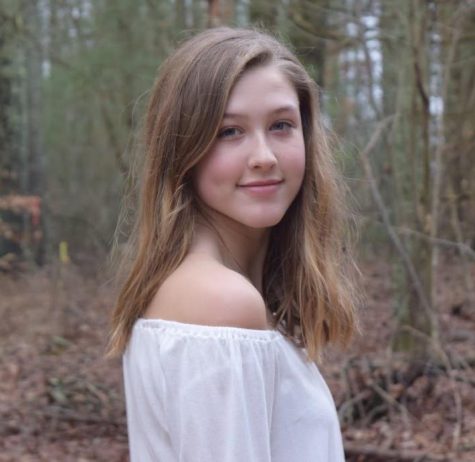
Elizabeth is a member of the class of 2023 and is from Richmond, Rhode Island. She is a double major in English and chemistry and is also a member of...
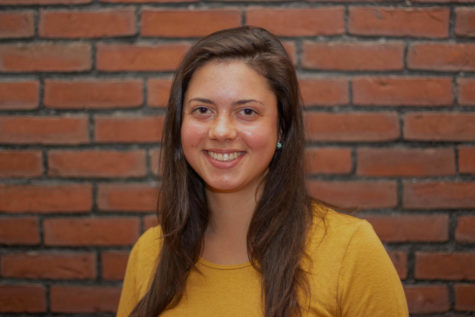
Amelia Keleher ('21) is an American Studies major interested in sustainable and equitable food systems. She grew up in Corrales, New Mexico and Amersfoort, The...



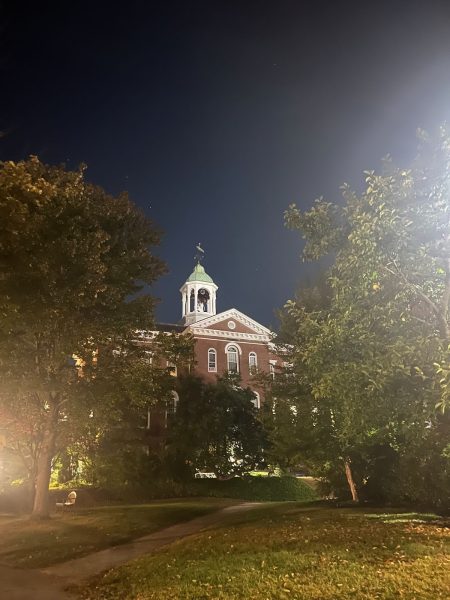

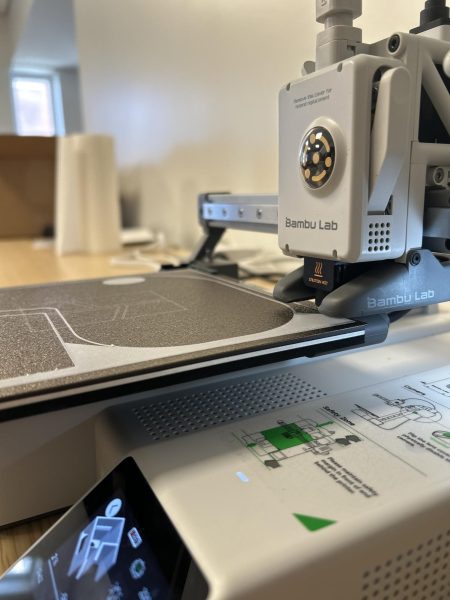
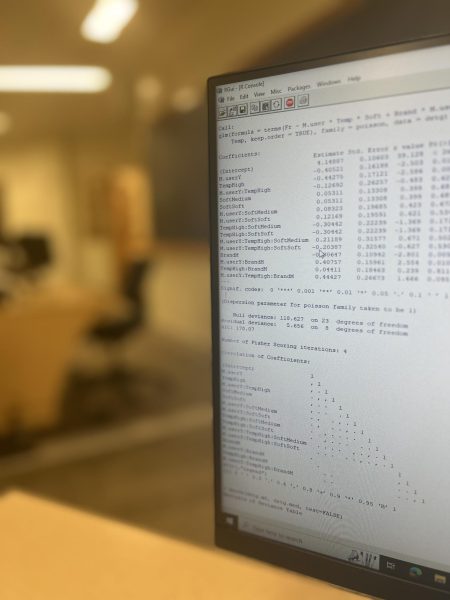
John Dawkins • Nov 13, 2020 at 5:24 PM
Well if they wanted to advertise the lack of meaning any degree from their school has, this was a great way to do it.
Definitely won’t be hiring any Bates graduates in the future, which is a shame because my field is booming (we mostly hire chem majors as pharmacy techs).
For a school that has 90% of their students not even from the state, it’s certainly attracting the bottom of the barrel from everywhere.
Steven Robins • Nov 11, 2020 at 8:56 PM
I am disappointed that the administration removed the responses to the Instagram post and even more disappointed that they removed the profile. Bates College has one of the oldest and most storied Debate programs in the US. Historically this group has explored sensitive issues including the WW II US use of the atomic bombs, allowing the world to benefit from Nazi experiments done on POWs and civilian prisoners, the systemic racism of the US penal code, and the stain of slavery on our national character. While both actions are unacceptable, creating a safe space for the minority (in this case the Republicans) to voice their opinions is critical to the ultimate health of school. Would have been a great opportunity for a debate resolution like ;This House Believes that there is no measurable difference between Republicans abs racists. I don’t agree with the statement but it’s debatable.
Archibald Fenton • Nov 11, 2020 at 10:07 AM
Um, they’re protesting suppression of free speech, yet, that’s exactly what the students are doing. And the administration caves.
Andrew • Nov 11, 2020 at 8:08 AM
As mentioned above, the irony is pointed out about silencing someone with a different viewpoint, and the article clearly points out that the organizers silenced themselves! The two main organizers of the protest were slated to have their profiles highlighted in the Instagram post as well… just baffling at the absurdity of it all.
Susan • Nov 10, 2020 at 2:09 PM
Are you not even upset that one side is silenced. As an American are you not aware of the realty of the world? Being a conservative or Republican means you support a set of values or viewpoint, not just a particular person. I would be scared of a school that I paid to attend would be so easily swayed to pressure into submission your administration. 1 out of 11 that was all.
CD • Nov 10, 2020 at 12:26 PM
>>> How ironic is it that the sign say “Bates will not silence us” while attempting to silence the views of someone.
>>> What was the actual content of the profile that got these students so upset? Isn’t that a relevant part of this story?
Both of these are very valid points that are missing from this article.
Michael Kossin • Nov 10, 2020 at 12:01 PM
What was the actual content of the profile that got these students so upset? Isn’t that a relevant part of this story?
TB • Nov 10, 2020 at 10:59 AM
How ironic is it that the sign say “Bates will not silence us” while attempting to silence the views of someone..